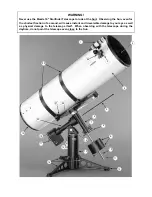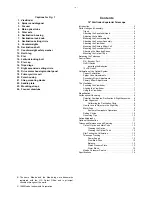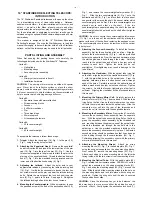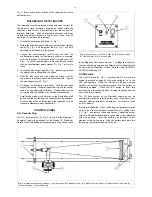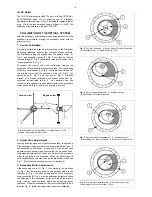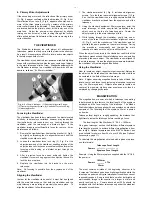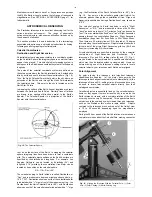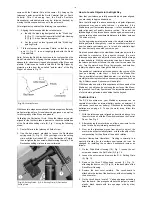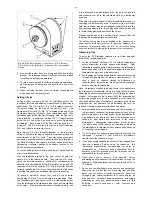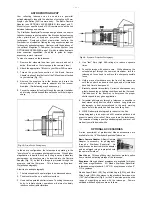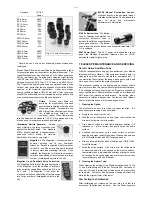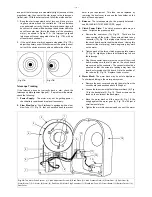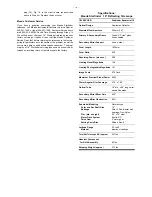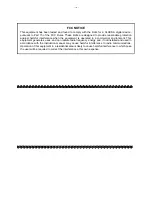
- 7 -
4. Primary Mirror Adjustments
If the secondary mirror and the reflection of the primary mirror
(1), Fig. 8, appear centered within the drawtube (2), Fig. 8, but
the reflection of your eye (3), Fig. 8, appears off-center, one or
more of the three primary mirror hex screws of the primary
mirror cell will need to be adjusted. These primary hex screws
are located behind the primary mirror, at the lower end of the
main tube. Adjust the primary mirror alignment by slightly
turning one hex screw at a time, looking through the focuser
after each adjustment to determine if the mirror is moving in the
correct direction.
THE VIEWFINDER
The Starfinder telescope, as with almost all astronomical
telescopes, presents a fairly narrow field of view to the observer.
As a result, it is sometimes difficult to locate and center objects
in the telescope’s field of view.
The viewfinder, by contrast, is a low-powered, wide-field sighting
scope with crosshairs that enables the easy centering of objects
in the main telescope’s field of view. Standard equipment with
the Starfinder telescope is a viewfinder of 8-power and 50mm
aperture, called an “8 x 50mm viewfinder.”
1. The viewfinder bracket (4), Fig. 9, includes six alignment
screws. Turn the three rear-most alignment screws (1), Fig.
9, so that the viewfinder tube is roughly centered within the
viewfinder bracket, as viewed from the eyepiece-end of the
telescope.
2. Using the standard equipment 25mm eyepiece, point the
main telescope at some easy-to-find, well-defined land
object, such as the top of a telephone pole. Center the
object precisely in the main telescope's field.
3. While looking through the viewfinder, gently turn one or
more of the three front-most viewfinder alignment screws
(2), Fig. 9, until the crosshairs of the viewfinder point at
precisely the same position as the main telescope. During
this procedure, occasionally look through the main
telescope to make sure the object is still centered.
When the object is centered in the viewfinder, confirm that the
viewfinder's crosshairs and the main telescope are now pointing
at precisely the same object. The viewfinder is now aligned to
the main telescope. Unless the alignment screws are disturbed,
the viewfinder will remain aligned indefinitely.
Using the Viewfinder
Now, to locate any object, terrestrial or astronomical, first center
the object on the crosshairs of the viewfinder; the object will then
be centered in the field of the main telescope.
Note: If higher observing magnifications are to be utilized, first
locate, center, and focus the object using a low-power eyepiece
(e.g., the 25mm eyepiece). Objects are easier to locate and
center at low powers; higher power eyepieces may then be
employed by changing eyepieces.
MAGNIFICATION
The magnification, or power, at which a telescope is operating
is determined by two factors: the focal length of the eyepiece
employed and the focal length of the telescope. The Meade
Starfinder telescope is supplied with one eyepiece as standard
equipment. The focal length of the eyepiece, 25mm, is printed
on its side.
Telescope focal length is, roughly speaking, the distance that
light travels inside the telescope before reaching a focus.
The focal length of the Starfinder 16” f/4.5 = 1830mm.
On a given telescope, such as the Starfinder, different eyepiece
focal lengths are used to achieve different magnifications, from
low to high. Optional eyepieces and the #140 2x Barlow Lens
are available for powers from 36x to over 500x (see Optional
Accessories, page 11).
To calculate the magnification obtained with a given eyepiece,
use this formula:
Power =
Telescope Focal Length
___________________
Eyepiece Focal Length
Example: Using the 25mm eyepiece supplied with the 16" f/4.5,
the power is:
Power =
1830mm
_______ = 73x
0
25mm
The most common mistake of the beginning observer is to
“overpower” the telescope and use high magnification which the
telescope’s aperture and typical atmospheric conditions cannot
reasonably support. Keep in mind that a smaller, but bright and
well-resolved, image is far superior to a larger, but dim and
poorly resolved, one. Powers above about 300x should be
employed with the Starfinder telescope only under the steadiest
atmospheric conditions.
Fig. 9: 8 x 50mm Viewfinder. (1) Rear-most Alignment Screws;
(2) Front-most Alignment Screws; (3) Viewfinder Focus Lock Ring;
(4) Mounting Bracket.
1
2
4
3
Focusing the Viewfinder
The viewfinder has been factory prefocused to objects located
at infinity. Individual eye variations, however, may require that
the viewfinder be refocused to your eye. Looking through the
viewfinder, point the telescope at a distant object; if the
viewfinder image is not sufficiently in focus for your eye, it may
be refocused as follows:
1. Remove the viewfinder from its mounting bracket (4), Fig. 9,
by slightly unthreading the six alignment screws until the
viewfinder can slip out easily.
2. Loosen the viewfinder focus lock ring (3), Fig. 9, at the
objective-lens-end of the viewfinder, enabling rotation of the
objective lens cell clockwise or counterclockwise for precise
focusing while looking at a distant object through the
viewfinder.
3. After a precise focus has been achieved, tighten the
viewfinder focus lock ring against the objective lens cell to
lock the focus in place.
4. Replace the viewfinder into its bracket on the main
telescope.
Note: No focusing is possible from the eyepiece end of the
viewfinder.
Aligning the Viewfinder
In order for the viewfinder to be useful, it must first be aligned
with the main telescope, so that both the viewfinder and the
main telescope are pointing at precisely the same place. To
align the viewfinder, follow this procedure:


